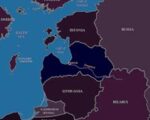At DSEI 2025 in London, Danish defense firm Sky-Watch presented its RQ-35 Heidrun unmanned aerial vehicle (UAV)—a compact yet robust tactical ISR platform designed for frontline operations. With a flight endurance exceeding 90 minutes and demonstrated resistance to electronic warfare (EW) environments such as those in Ukraine, the Heidrun is gaining traction as a NATO-compatible alternative to commercial off-the-shelf (COTS) drones increasingly vulnerable to jamming and spoofing.
Design Philosophy: Bridging the Gap Between COTS Drones and Military UAS
The RQ-35 Heidrun fills a critical niche between inexpensive commercial drones like DJI quadcopters and larger Group 2/3 military UAVs such as the Puma or Raven. Developed by Sky-Watch A/S—a Danish company specializing in aerial robotics—the Heidrun is optimized for short-range reconnaissance missions at the battalion level. It is hand-launched and recovered via belly landing or parachute recovery system depending on configuration.
Weighing approximately 3.5 kg with a wingspan of around 1.6 meters, the fixed-wing airframe is constructed from composite materials for durability while maintaining portability. The system fits into a single backpack-sized container for dismounted operations and can be deployed by two operators within five minutes.
Performance Specifications and Payload Capabilities
The RQ-35 offers an operational range of up to 25 km under line-of-sight conditions using encrypted digital datalinks. Its electric propulsion system supports flight durations of over 90 minutes depending on payload configuration and environmental conditions.
The primary payload is an electro-optical/infrared (EO/IR) gimbal capable of providing stabilized full-motion video (FMV) for day/night surveillance. The sensor suite includes:
- HD daylight camera with optical zoom
- Thermal imaging sensor for night ops or low visibility
- Laser pointer or target marker optional in some variants
The onboard mission computer supports real-time video encoding and metadata tagging compliant with NATO STANAG standards for integration into broader C4ISR architectures.
Proven Operational Use in Ukraine’s Electronic Warfare Battlespace
The RQ-35 has seen extensive operational use by Ukrainian forces since early 2023 under various bilateral aid packages from Denmark. According to Ukrainian military sources cited by Defense Express and Army Recognition, the drone has demonstrated notable survivability against Russian electronic warfare systems including GPS jamming and RF denial platforms such as Leer-3 and Pole-21.
This performance stems from several design features:
- Dual GNSS receivers supporting both GPS and GLONASS/Galileo constellations
- Encrypted telemetry links hardened against spoofing attempts
- Pre-programmed autonomous flight paths allowing mission continuation during comms loss
- Antenna diversity systems that mitigate directional jamming effects
This level of EW resilience makes the Heidrun markedly more survivable than Chinese-made COTS drones widely used earlier in the war but now increasingly ineffective due to Russian counter-UAS measures.
NATO Interoperability and Training Integration
The RQ-35 has been adopted not only by Ukrainian forces but also evaluated by multiple NATO countries including Denmark, Estonia, Lithuania, Germany, Poland, and the UK. Its compliance with NATO STANAG protocols enables seamless integration into allied command-and-control networks via common interfaces like Link-16 gateways or ATAK plugins.
Sky-Watch offers modular training packages tailored to different user levels—from basic operator courses to advanced mission planning modules—allowing rapid fielding without long lead times typical of larger UAS programs.
Tactical Role Evolution Amid Changing Drone Doctrine
The rise of FPV kamikaze drones has shifted battlefield drone doctrine toward expendability—but systems like the Heidrun offer enduring value where persistent ISR is required without risking manned assets or relying on vulnerable quadcopters. Its low acoustic signature (<40 dB at cruising altitude), high-resolution sensors, autonomous navigation modes, and robust comms make it ideal for:
- BDA (battle damage assessment)
- Cueing artillery fire missions via real-time coordinates feed
- SAR overwatch during special operations raids or urban clearing tasks
- Tactical mapping prior to armored maneuver advances
DSEI Spotlight Reflects Growing Demand for Mid-Tier Tactical UAS Solutions
DSEI 2025 highlighted growing interest among European militaries for ruggedized Group I/II-class UAVs that can survive contested electromagnetic environments while remaining logistically light. With its combat-proven track record in Ukraine’s dense EW battlespace—and support from a Scandinavian defense ecosystem focused on modularity—the RQ-35 appears well-positioned to fill this demand segment.
Outlook: Scaling Production Amid NATO Procurement Trends
Sustained demand from Ukraine combined with emerging NATO interest has prompted Sky-Watch to scale production capacity through partnerships across Europe. As part of Denmark’s ongoing support initiatives under EDA frameworks such as EUMAM-UA (European Union Military Assistance Mission – Ukraine), additional batches are expected through Q1–Q3 2026.
If current battlefield trends continue—where survivability against EW becomes paramount—the future may favor resilient fixed-wing platforms like the RQ-35 over less sophisticated multirotor solutions that dominated early conflict phases but now face growing attrition rates due to Russian countermeasures.









